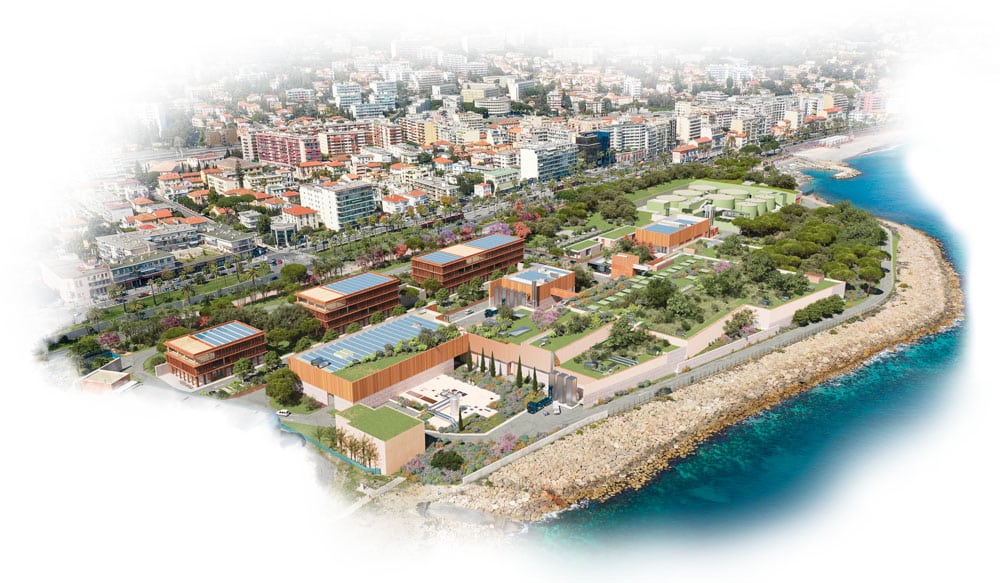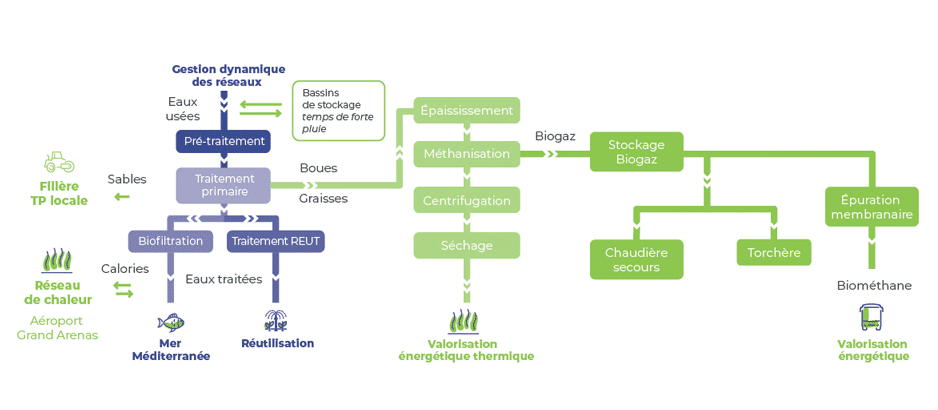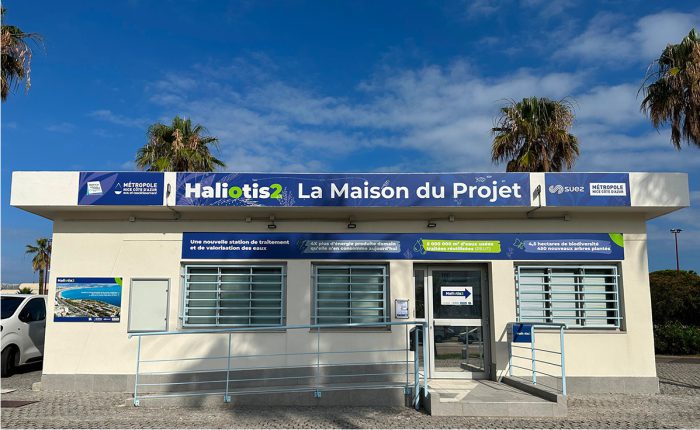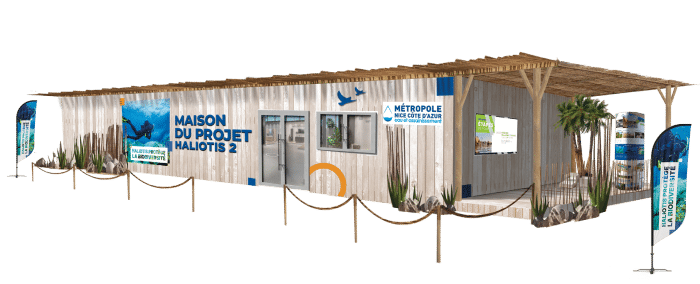Eccological innovation for our region
Why Haliotis 2 ?
Against a backdrop of climate emergency and dwindling resources, water conservation has become a major issue for our populations. While the current plant complies with current regulations, it has become necessary to anticipate the ageing of the installations to guarantee long-term compliance with future standards, while anticipating the future needs of the metropolitan area.
Haliotis 2 will thus contribute to achieving the ambitious objectives of the Metropole’s Territorial Climate Air Energy Plan, thanks to the creation of a genuine technological and sustainable development hub capable of producing new sources of decarbonated energy while treating microplastics and promoting the circular economy through the massive reuse of treated wastewater.

Pourquoi Haliotis 2 ?
Pourquoi Haliotis 2 ?
Dans un contexte d’urgence climatique et de raréfaction des ressources, la question de la préservation de l’eau est devenue un enjeu majeur pour nos populations. Si la station actuelle respecte les réglementations en vigueur, il devenait nécessaire d’anticiper le vieillissement des installations pour garantir la conformité à long terme de l’installation avec les normes à venir tout en anticipant les besoins futurs du territoire métropolitain. Haliotis 2 contribuera ainsi à la complétion des objectifs ambitieux du Plan Climat Air Energie Territorial de la Métropole grâce à la création d’un véritable pôle technologique et de développement durable capable de produire de nouvelles sources d’énergies décarbonées tout en traitant les microplastiques et en favorisant l’économie circulaire par la réutilisation massive des eaux usées traitées.
Protecting the Mediterranean
-90%
of microplastics
in treated wastewater
26
municipalities served
or 680,000 population equivalents by 2030
Smarter network management
based on AI and data analysis
Haliotis 2 will modernize the existing site with new, high-tech facilities, thus providing better protection for the Mediterranean. The new treatments installed at the plant and their upgradeable design will enable us to anticipate and meet the most stringent regulatory requirements for water quality.
Haliotis 2 will thus eliminate 90% of microplastics, and will have two industrial demonstrators to evaluate treatments against micropollutants of 150 cubic meters (m3) per hour (endocrine disruptors, emerging substances).
Haliotis 2 will also increase the site’s treatment capacity to meet the future needs of the Nice Côte d’Azur metropolitan area. The plant currently treats wastewater from 20 communes of the Metropole, representing almost 60% of the metropolitan area’s volumes. Haliotis 2’s capacity will be increased to 680,000 population equivalents, enabling it to treat effluent from 6 additional communes on the right bank of the Var (Saint-Laurent-du-Var, La Gaude, Saint-Jeannet, Gattières, Carros and Le Broc), for a total of 26 communes, and to take account of demographic trends.
Finally, more intelligent network management, based on artificial intelligence and data analysis, will enable us to anticipate and better manage rainfall events and their consequences. In wet weather, it will smooth out the flows treated in the plant and optimize the filling of the Ferber and Arson basins. The risk of spills will thus be limited and bathing water quality better protected.
A station producing renewable energy
43
GWH/year
of biomethane produced to heat the equivalent of 11,000 homes or to provide biofuel for the equivalent of 290 buses
4X
more energy
produced than it consumes today
15 000
metric tons
of CO2 avoided per year
The construction and operation of Haliotis 2 will be low in raw materials and energy, and will make maximum use of on-site resources.
The new Haliotis will produce four times more energy than it consumes today. The plant will be part of the circular economy: all wastewater treatment products will be used to produce and export sustainable resources and renewable energies for the region. It will thus contribute to the Plan Climat Air Energie Territorial (PCAET) of the Métropole Nice Côte d’Azur.
Biomethanization of sludge
The new Haliotis plant will optimize the energy recovery of sludge from wastewater treatment. Haliotis 2 will produce 43 GWh per year of biogas, a local renewable energy, which will be 100% recovered and used to produce the gas needed to power 11,000 homes or 290 buses. The system will cut CO2 emissions by a factor of 18 compared with fossil gas, and will contribute to a 55% reduction in emissions for the Metropole by 2030.
Heat recovery
Calories from treated wastewater before their discharge into the sea will be recovered, producing 27 GWh/year of heat for the Grand Arenas district and the airport.
The calorific value of sludge
The calorific value of dried sewage sludge (26 GWh/year) will contribute to the production of heat and steam at the Ariane waste-to-energy plant.
The volume of sludge produced will be reduced by 70% compared with the current plant, reducing the number of trucks by a factor of 3 and the number of kilometers traveled by a factor of 13.
The trucks will run on green fuels. What’s more, by treating the sewage sludge on site – rather than in the Bouches-du-Rhône and Vaucluse regions – the number of trucks needed for the plant will be reduced by 70%, and the number of kilometers traveled on the roads by heavy goods vehicles by 93%.
Reuse of treated wastewater
5 Mm3
reused treated water (REUT) for watering green spaces and cleaning roads
REUT
600 m3/h
European A-Class
<1 mg/l
Ammoniacal nitrogen concentration at the end of the REUT process
80%
for micropollutant removal
On the innovation demonstrator (150m3/h)
Against a backdrop of increasing water stress, Haliotis 2 will contribute to the rational management of water resources. By 2028, the Nice metropolitan area will have an industrial treated wastewater reuse unit capable of recycling 5 million cubic meters of water per year in the area.
This installation will cover the watering needs of the City of Nice’s green spaces and road cleaning, with water that will no longer be taken from the natural environment (groundwater and springs): a considerable water resource conservation measure.
Since July 2023, an initial pilot unit for reusing treated wastewater has been operational to water Haliotis’ green spaces.
When the plant is commissioned, 2 coherent and complementary processes will be deployed for WASTE to offer optimal sanitary safety and a platform for comparative research between the 2 processes. These 2 processes will be effective in the fight against drug residues and endocrine disruptors.
The REUT will cover the following needs internally on Haliotis 2 :
- Arrosage espaces verts internes usine : 720 m3/j de mars à septembre, soit 30 m3/h en lissage sur 24h grâce au stockage d’EUT
- Besoins process et points de lavage : 480 m3/j, soit 20 m3/h en lissage sur 24h grâce au stockage d’EUT
In all, 15,000 tonnes of CO2 equivalent will be avoided every year from 2030 thanks to the valorization of biomethane, dried sludge and treated water.

Preserving the quality of life of local residents and the Promenade des Anglais

+68%
of permeable surface
compared with today

4,5
hectares
will be created at the entrance to the town.
600
trees
a true biodiversity carrier
Particular care has been taken to integrate the landscaping and architecture into the exceptional setting of the Promenade des Anglais. The station’s environment will be enhanced to preserve the quality of life for local residents, thanks to the planting of vegetation on the site to encourage soil permeability and eliminate the risk of odors.
Haliotis 2 will have 68% more permeable surfaces than at present, helping to return rainwater to the ground and reduce urban runoff.
Focus on biodiversity.
A 4.5-hectare biodiversity island of freshness will be created at the entrance to the town, with almost 600 trees and hedges. The species selected will be adapted to the region and non-allergenic. They include edible species such as Thyme, Rosemary, Olive, Savory and Azar. The site’s woodland, with its wide variety of species and habitats, will be a real source of biodiversity, enhanced by the installation of features to encourage small fauna such as insects, amphibians and small birds to flourish. Similarly, bird and insect nesting boxes will be installed in the trees, site lighting will be adapted to the fauna present, and existing vegetation (umbrella pines, palm trees, olive trees, etc.) will be replanted on the site.

A drastic reduction in nuisance

1 worksite
then a committed plant
for controlled nuisance
303 900 m3/h
overall capacity
site deodorizations
20 sensors
for continuous measurement
Noise, odors and dust
The new Haliotis will be rebuilt in situ, while the existing plant will continue to operate throughout the construction work and the gradual commissioning of the new structures.
A range of state-of-the-art solutions will be implemented during the construction phase to drastically reduce nuisance.
During the works, 20 sensors for continuous measurement of noise, odours and dust will ensure comprehensive monitoring of nuisances. A monitoring platform will be set up, the results of which will be made public on a regular basis.
When the new facilities are commissioned, the new plant will feature more than 28 ultra-efficient deodorization towers capable of treating 300,000 m3 of air per hour, and a hypervision center will be set up for immediate reactivity.
A committed project to control nuisances
A clean worksite charter has been produced for the construction phases of the project. It specifies the measures taken by companies to comply in every respect with the Nice Côte d’Azur Metropolitan Authority’s Green Worksite Charter (Charte Chantier Vert).
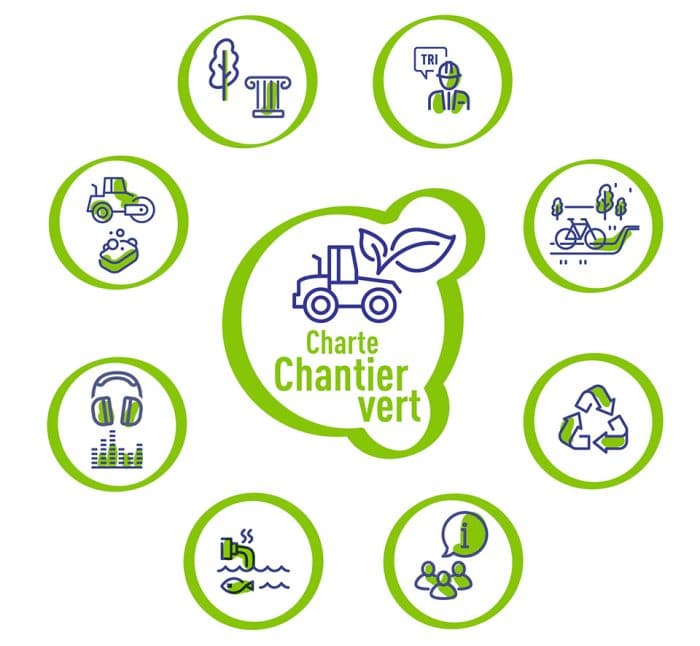
In addition, Haliotis 2 is committed to the “Attitude Environnement” clean worksite label, through compliance with 10 criteria based on applicable regulatory requirements, certification standards (ISO 14001, etc.) and best practices observed on worksites operated by the Contractor.
A complex open to its territory and its inhabitants

65%
of sales
entrusted to local companies
260
jobs
123 000
hours
of professional insertion
The Haliotis 2 project has been designed to welcome the public and raise awareness among future generations of the challenges of ecological transition.
Cooperation with local change actors
Haliotis 2 will become a veritable catalyst for environmental research in the metropolitan area, with an innovation laboratory working on REUT, micropollutants and microplastics, as well as a partnership with the Université Côte d’Azur and the Institut méditerranéen du risque de l’environnement et du développement durable (IMREDD).

Contributing to local economic and social development
This new Haliotis will contribute to the economic and social development of the region, by entrusting 65% of sales to the local economy, with at least 15 local companies involved throughout the project, and by offering 123,000 hours of professional integration and 30,000 hours of training and work-study.
In all, the project will generate some 260 jobs, 200 during the construction phase and 60 during the operating phase.
Haliotis 2, voluntarily opening up to local residents and beneficiaries
Public meetings, a “Jury de nez”, a space for exchange and project encounters, have enabled Haliotis 2 to begin opening up to its local community. An interactive website, regular news updates and a brochure presenting the project will complete the range of tools available to local residents and anyone interested in following the project between now and the start of construction, scheduled for early summer 2024.

